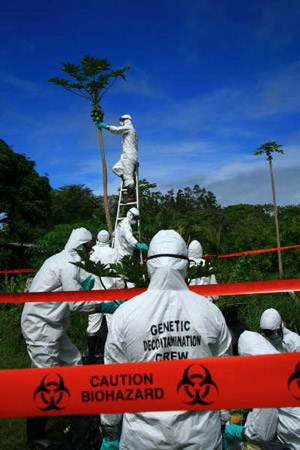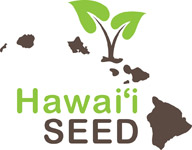Papaya
 GMO Papaya contamination
GMO Papaya contamination
Information on contamination of Hawai’i Island papaya by genetically engineered varieties
In 1998, the first GMO Papaya was commercially released into Hawaii’s growing environment. Dr. Dennis Gonsalves and Dr. Richard Manshardt created this papaya ringspot virus (PRSV) resistant GMO fruit and were experimenting with its release in PRSV ridden Puna, the main papaya growing area of Hawaii. While the GMO Papaya is resistant to papaya ringspot virus, it brought many more problems than it solved. The GMO Papaya has closed lucrative export and organic markets and always has a low price point. This technology has come with too many strings attached and Hawaii has lost almost half of its papaya farmers.
Another unintended problem is GMO contamination. In 2003, GMO Free Hawaii became very concerned with the gene flow of the GMO Papaya. First, we used the GUS gene test to see how much contamination was on our farms and in our community. After consistently finding 30-50% of the seeds and leaves we tested having some kind of air or seed contamination, we wanted to know more. We put out calls for independent, peer-reviewed academic studies to examine the levels of this GMO Papaya contamination, to no avail. In 2004, GMO Free Hawaii designed a study to look at the extent of GMO contamination around the state.
The methodology of this Pilot Survey included three composite samples of approximately 10,000 seeds from around the islands (Hawaii, Oahu, Kauai) being collected from non-GMO growing locations such as organic and conventional farms, backyard gardens and feral roadsides. Two composite samples each of seeds and leaves from organic farms were collected on Hawaii and Kauai. Three samples of University of Hawaii non-GMO seed varieties were purchased directly. Seeds and leaves were sent to an independent laboratory, Genetic ID, for PCR (Polymerase Chain Reaction) industry standard testing.
The results indicate massive GMO contamination of papaya seeds on Hawaii Island, of the order of 50%, substantial GMO contamination on Oahu (<5%) and thankfully, only traces of contamination on Kauai (0.0%). Both organic farms tested had no GMO trees unintentionally planted, but sadly, were discovered to have air contamination of the seeds in their fruits (<5% on Hawaii Island and 0.01% on Kauai). Most shocking was the GMO contamination of the University of Hawaii’s non-GMO papaya seed supply (Waimanolo Solo variety) at greater than 0.01% but less than 0.1%.
In 2006, we repeated this last test and found the Waimanalo Solo to still be GMO contaminated at the same percentage. As the University of Hawaii claims not to be growing this seed near GMO Papaya trees, they must have untested GMO trees in their non-GMO orchards or not be bagging the flowers properly to keep out unwanted GMO pollen.
The two main routes of GMO contamination appear to be air and seed contamination. Air contamination refers to GMO contamination of the seeds by GMO pollen flow traveling by wind, insect, animal or human. Flesh of the fruit may be non-GMO while any number of seeds inside may be GMO. Seed contamination refers to unintended GMO contamination of the traditional seed supply leading to unintended GMO trees, which have GMO leaves, fruit flesh, and at least three quarters GMO seeds. Most concerning has been the loss of lucrative export and organic markets caused by the GMO Papaya contamination leading to expensive testing and roguing to non-GMO Papaya growers.
The University of Hawaii and Pacific Research Basin have responded inadequately to the news of our test results. Their insufficient attempts at follow- up studies have included testing too few UH seeds to provide statistically significant results, a pollen study by an undergraduate on the island with the least contamination and a promise of a study by Carol Gonsalves (Dr. Gonsalves’ wife) that has not materialized. Promises of GUS testing for papayas being available to farmers and gardeners through the Cooperative Extension service have not materialized either. Finally, no attempts at GMO Papaya clean-up by the responsible institutions have been made, to date.
Finally, a pilot study by Hawaii SEED shows more GMO Papaya contamination than anyone expected. Our recommendations include:
- Governments around the globe should not introduce the GMO Papaya into any new growing regions. Even as a field trial, GMO Papaya cannot be contained.
- Considering the adverse consequences of the GMO Papaya, the Hawaii Department of Agriculture should not commercially release any more GMO crops in Hawaii.
- The University of Hawaii should clean up the GMO contamination in their non-GMO papaya seeds before selling any more.
- GMO Papaya testing should be offered to Hawaii Island farmers and gardeners either free of charge or at a nominal cost by the University of Hawaii and PBARC/USDA (Pacific Basin Agriculture Research Center/United States Department of Agriculture), so they can rogue out GMO Papaya contamination.
- Education about using traditional and alternative methods of Papaya ringspot virus management including introducing PRSV tolerant3 varieties should be actively offered to farmers by the University of Hawaii and PBARC/USDA .
- An independent peer-reviewed study examining the full extent of the GMO Papaya contamination in Hawaii should be authorized by the Hawaii Department of Agriculture.
- An independent peer- reviewed study examining the possible health effects on humans of the GMO Papaya consumption should be authorized by the Hawaii Department of Agriculture.
